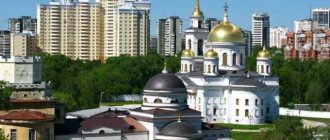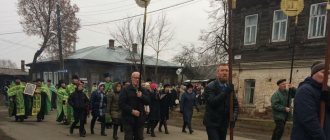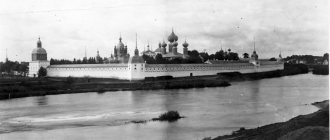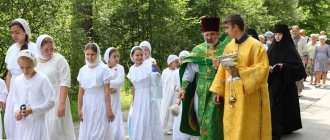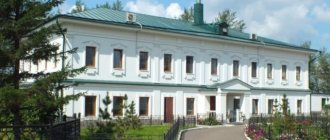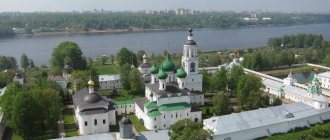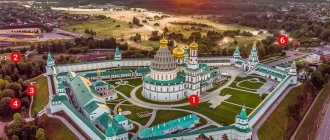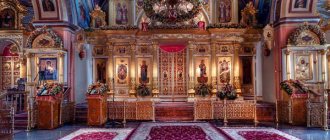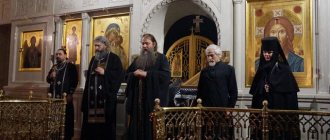Vvedensky Convent in Tikhvin (Russia) - description, history, location. Exact address and website. Tourist reviews, photos and videos.
- Last minute tours
to Russia
1/
10
Vvedensky Convent in Tikhvin
Once one of the largest monasteries in Russia, the Vvedenskaya Monastery in Tikhvin was founded in 1570. It appeared on the site where, according to chronicle sources, the famous Tikhvin Icon of the Mother of God first appeared. The monastery was destroyed more than once and began its more or less quiet life only a century after its consecration, towards the end of the 16th century. Having reached its peak by 1917, after the establishment of Soviet power it was used as a gym and even as a children's colony. The revival of the Vvedensky Convent began only in 2005, and already 4 years later regular services began to be held here.
History of the monastery
Founding of the monastery
The Vvedensky Convent is considered the “sister” of the Tikhvin Mother of God Assumption Monastery, with which it was founded simultaneously, by decree of Ivan the Terrible on February 11, 1560, by Novgorod Archbishop Pimen.
| “The Vvedensky Monastery always has an inextricable spiritual relationship with the Great Tikhvin Monastery, and forms, as it were, one monastery with it. Processions of the cross, held in the monastery on the temple feast of the introduction and on Bright Week on Thursday, always take place with the Tikhvin icon and honest crosses from the large monastery. Visits to the Highest Persons of the Royal House, Archpastors and other important persons after the large monastery, also happen for the Vvedensky monastery.” |
Pre-synodal period
The history of the monastery has become known since the beginning of the 17th century, when in 1604 the nun-queen Daria, the fourth wife of Ivan the Terrible, and her two nieces, princesses Leonida and Alexandra Grigorievna Gagarin, moved here from the Goritsky Resurrection Monastery.
Abbess Daria “was locally venerated in Tikhvin in honor of the Entry into the Temple of the Most Holy One. Mother of God Monastery.
During the Polish-Swedish intervention, the Vvedensky Monastery was devastated by the Lithuanians and Swedes: in comparison with the Assumption Monastery, it was weakly fortified, which allowed the Swedish troops under the leadership of Jacob Delagardie to occupy the monastery during the Tikhvin siege, locate their headquarters here and, leaving, burn all wooden buildings (September 14, 1613). According to legend, during attacks by enemy troops, the nun-Tsarina Daria and her companions “hid in the wilderness of impassable swamps, and after the end of the disaster, they gathered for worship and prayer in a dilapidated monastery.” According to another story, after the fire and before the Peace of Stolbov, the nuns lived in a dugout on a small lake six miles from the monastery, named “Tsaritsyn” in memory of those events. However, there is no direct documentary or archaeological evidence of this.
After the conclusion of the Stolbovsky Peace, work began to restore and strengthen the monastery. During this period, Tsar Mikhail Fedorovich granted the Vvedensky Monastery a number of lands, and the monastery received donations from royalty and private individuals. After the death of the nun-Queen Daria, according to her spiritual will, the monastery received her patrimony near Ustyuzhnaya.
XVIII century
In 1739-1764, a description of the monastery was made for the Novgorod diocese:
| “In that monastery there are two stone churches, there are five altars in them, of these churches there are two cellars under the cathedral church, they both have stone vaults, these churches are roofed with double planks, the domes are upholstered with jagged scaly shingles, the crosses on these churches are wooden, covered with tin. There is one stone bell tower, on it there are two medium and six small bells; Of these small bells, one is split; this bell tower is covered with planks without heads. At the Church of the Nativity of the Virgin Mary there is only one stone bakery cell; attached to it is a canopy with a dilapidated wooden closet, covered with shingles. The abbess has five wooden cells and one vestibule, one closet, one basement, covered with planks.” |
Before the secularization reform of 1764, the monastery owned up to 1,338 souls, 380 acres of arable land and some lands.
XIX century - early XX century
At the end of the 19th - beginning of the 20th century, the Vvedensky Monastery was one of the twelve richest monasteries in the Russian Empire, with a capital of over 100 thousand rubles.
In the reference book “Orthodox Russian Monasteries” of 1910 there is the following description of the monastery:
| There are two temples. The main cathedral church in honor of the Introduction with two chapels. On the left side of the cathedral at the entrance stands the tomb of Queen Daria; An unquenchable lamp burns above her. On the right side of the temple, near the iconostasis, several arks with holy relics are kept on a lectern. In the altar near the mountainous place there is an ancient icon of the Tikhvin Mother of God, which belonged to Queen Daria. Attached to the cathedral church is a church in honor of the Nativity of St. Mother of God. The sacristy houses several remarkable manuscripts from the 17th and 18th centuries, including the spiritual testament of Queen Daria. A strict charter has been introduced in the monastery. Among the indispensable duties of nuns is the vigilant reading of the Psalter with remembrance of the health and repose of the benefactors of the monastery. |
Soviet period
After the revolution, the Soviet government placed a children's colony and a number of non-church institutions in the monastery. The sisters of the monastery spent some time in the monastery buildings along with the new settlers who moved in there. In 1929 the monastery was finally closed; Abbess Joannikia remained to live in Tikhvin and was shot during the Great Terror.
In Soviet times, the cathedral was turned into a sports hall, changing rooms were placed in the vestibule, and a bathhouse, shower and toilet were installed in the altar.
At the end of the 1980s, they decided to restore the monastery: in the documents of the KGIOP of the Leningrad region there are developments of project proposals for the restoration of the architectural ensemble of the Tikhvin Vvedensky nunnery from 1988, indicating emergency work for 1990, but they were not carried out.
Current state of the monastery
In the spring of 2005, the revival of the Tikhvin Vvedensky Monastery began. With the blessing of the rector of the Tikhvin Dormition Monastery, Abbot Evfimy (Shashorin), the autonomous non-profit organization (ANO) “Revival of the Vvedensky Maiden Monastery” was created and registered, headed by L. B. Bolshakova (now nun Anfisa).
On April 10, 2005, the first prayer service took place in the gate church of the Vvedensky Monastery. The prayer service was served by Priest Sergius Remizov.
On December 25, 2009, the Holy Synod of the Russian Orthodox Church decided to open the Tikhvin Vvedensky Convent. Nun Tabitha (Fedorova) was appointed the abbess of the monastery.
On September 29, 2011, the abbess of the Vvedensky Monastery, nun Tabitha (Fedorova), was elevated to the dignity of abbot.
At the beginning of restoration work in the monastery, the buildings on its territory were not owned by the Church. The nuns were forced to rent premises and serve in the absence of heating. Until January 2012, a martial arts school was located in the Vvedensky Cathedral, and a sauna was located on the site of the altar; in the abbot's building there is an oriental martial arts club. Most of the wooden buildings were demolished due to their disrepair. The Cathedral of the Nativity of the Blessed Virgin Mary is in disrepair. Most of the monastery's brick fence has been destroyed.
Since 2009, regular divine services have been resumed in the monastery. The monastery is home to an abbess, 1 nun, and 2 novices. The service is performed by the serving hieromonk Innokenty (Gaida).
Workers and Orthodox laypeople who come to the monastery for obedience are participating in the restoration work (including within the framework of the project “Tikhvin. Touch the Shrine”).
- Description
- Pilgrimages (1)
- Trips here (15)
Description of the Vvedensky Convent in Tikhvin
Chronicle sources say that it was on the site of the future Vvedensky Small Monastery that the first appearance of the Tikhvin Icon of the Mother of God took place on the banks of the Tikhvinka River in the Novgorod province in 1383. Historians associate the circumstances of the appearance of the Tikhvin icon in Rus' with the Monk Anthony of Dymsky, who lived in Veliky Novgorod in the 13th century. After many years of pilgrimage, he became a hermit on Lake Dymskoye. The forested and wetlands of this Russian land were called the “country of Tifin.” It was here, 110 years after the death of St. Anthony, in 1273, that a miraculous icon was discovered, which became the heavenly patroness of the Novgorod lands.
Confirmation (evidence) that this is a Byzantine shrine came with Novgorod merchants from the Patriarch of Constantinople. Having learned from the arriving merchants about the miraculous appearance of the icon of the Mother of God in the Novgorod lands, the patriarch conveyed with them a description of the icon - “the baby’s leg is naked” - there could be no doubt...
However, in 1453, Constantinople was captured by the Turks... and the icon finally found the “House of the Most Holy Theotokos,” as Rus', the heir of Orthodoxy, has been called since ancient times.
...On the vast lands of the Tikhvin ridge of the Vepsk Upland and Ladoga region, among the tribes of the Finno-Ugric group, Russians, mainly Novgorodians, apparently began to settle in the 13th-14th centuries. “In 1383, during the days of Grand Duke Dmitry Ioannovich Donskoy, under Metropolitan Pimen, an icon of the Mother of God with the Eternal Child on her left hand appeared within Novgorod on Russian soil.” In 1383, at the site of the “discovery of the icon of the Mother of God”, at the crossroads of water and land roads, among several villages, the first wooden church of the Assumption of the Blessed Virgin Mary was erected, which laid the foundation for the graveyard, and then the “Great Monastery”. After several fires, at the behest of Grand Duke Vasily III, a stone cathedral was rebuilt in the image of the Assumption Cathedral of the Moscow Kremlin. In 1526, the Grand Duke himself visited the cathedral and prayed to the miraculous face. In 1547, according to the traditions of the Byzantine emperors, before the crowning of the kingdom, the cathedral was visited by the son of the Grand Duke, Ivan the Terrible.
The lands of the Prechistensky churchyard on the river. belonged to Tikhvin in the 15th century. Ivanovo Theological and Dormition Bogoroditsky Radogovitsky monasteries.
After the construction of the stone Assumption Cathedral in 1515 by Grand Duke Vasily III and, at the request of Ivan the Terrible, the establishment of the Assumption Monastery here in 1560, large urban planning work was carried out here. The settlement was moved to the hill near the village. Romanikha. The large monastery was carefully planned on the liberated and drained territory near the river and the Vyazhishchi stream.
The establishment of the Great Monastery in 1560 was accompanied at the same time by the introduction of the Vvedensky women's monastery.
Also, by decree of Tsar Ivan IV, the Big Posad (3) “Tikhvin” was formed and assigned to the Assumption Monastery, and the Small Posad - Vvedenskaya Sloboda, village - was assigned to the convent. Stretilovo. These works, starting in February 1560, with the participation of the Novgorod Bishop Pimen, were carried out by a talented builder - Novgorodian Fyodor Dmitrievich Syrkov.
Initially, the monastery occupied a relatively small area on the bank of the Berezovika stream (modern Vvedensky stream) and the entire ensemble created by F.D. Syrkov was wooden. In the 16th century, judging by the documents, only one building of the monastery is known - the wooden Church of the Entry of the Blessed Virgin Mary. About the existence of monastic cells in the 16th century. one can only guess. A wooden wall was erected around the monastery and a moat was dug.
Eupraxia became the first abbess of the monastery (February 1608). At all times, the Great Assumption Monastery attracted everyone's attention with the miraculous Tikhvin Icon of the Mother of God located there, and the Vvedensky Small Monastery was not mentioned anywhere until the fourth wife of Ivan the Terrible, Anna Alekseevna, appeared here, tonsured under the name Darius (active link to “On Monks” ")
John's marriage to Anna Alekseevna took place in 1572. The fourth marriage of Ivan the Terrible, contrary to all expectations, lasted three years. Need to think. The reason for this was Anna’s character, her intelligence, tact and awareness of her dignity, inherent in the citizens of the free city of Novgorod.
The queen was tonsured a monk at the Resurrection Goritsky Monastery. The arrival of Queen Darius at the monastery is interpreted as her exile after the betrayal of Prince Kurbsky, in whose house she was brought up and spent her childhood and youth, becoming an orphan at an early age. Other sources claim that it was a voluntary departure to monasticism... or that John IV “hid” Anna Alekseevna in the monastery for the purpose of salvation during the extermination of the boyar family of Koltovsky. There is no documentary information on this matter, just as there are no documents describing the first years of the life of the royal nun in the Vvedensky Convent.
On May 16, 1596, the former queen was already listed as the abbess of the Vvedensky convent “on Tifina.” Together with her, her two nieces, Leonida and Alexandra Grigorievna Gagarin, arrived here.
The monastery was given to Daria at full disposal as mistress and trustee.
She rebuilt it, enlarged it and brought it to a flourishing state. The Elder Queen Daria enjoyed special influence and business connections in the cities of Moscow and Tikhvin. In 1604, at the request of the queen, the abbess of the Vvedensky monastery left the subordination of the Great Assumption Monastery and received complete independence. At her request, starting in 1604, the kings granted the monastery a number of lands, villages and benefits, and also allocated funds for the stone building of the monastery. Under Darius, the first stone church was built - the three-domed Cathedral of the Entry of the Blessed Virgin Mary into the Temple with two chapels - in the center of the monastery, fenced with a wooden fence 187 fathoms long.
All other buildings were wooden: abbots' and monks' cells, barns, stables, a barnyard with associated buildings, workers' cells.
The resettlement of the queen-abbess coincided with the beginning of the Time of Troubles in Rus', the invasion of the Russian soil by the Lithuanians and Swedes.
During the Polish-Swedish wars with Russia, the Vvedenskaya monastery was repeatedly attacked and partially destroyed. In 1613 The Great Assumption Monastery was besieged, but not taken by the Swedes. The wooden buildings of the Vvedensky convent, not fortified militarily, were completely burned on September 14, 1613 by Swedish troops led by Magnus Delagardie. As legend has it, during enemy attacks, Queen Daria and her companions hid in the forests and swamps; returning to the dilapidated monastery during quiet days, they resumed worship. After the fire and right up to the Stolbovsky* world, the nuns lived with the queen - nun Daria in a dugout on the shore of a small lake six miles from the monastery, now called Tsaritsyn in memory of those events (about the life of the nuns during the Swedish occupation). However, there is no direct documentary or archaeological evidence of this.
Later (approx. XVIII - XIX centuries) a “memorial” chapel, a well and chains with crosses were built on Tsaritsino Lake.
After the Swedish devastation and fires of 1613, the queen-nun, starting in 1616. (?1619), rebuilt the cathedral and 5 cells. Five years later, the Vvedensky Monastery looked even better than before the Swedish invasion.
After the conclusion of the Peace of Stolbovo and until her death, Queen Daria worked on the restoration and strengthening of the monastery, creating churches, establishing monastic order and managing the monastery. During this period, Tsar Mikhail Fedorovich granted the Vvedensky Monastery a number of lands, donations came to the monastery from royalty and private individuals. The Queen herself, the nun, donated her entire fortune to the monastery, which she wrote down in her Spiritual Testament. On April 5, 1626, Abbess Daria (active link), having accepted the schema, died.
In gratitude for her diligent service, the Queen-nun was buried in the Vvedensky Cathedral Church, and a gilded tomb was erected over her grave.
After the repose of Daria, the Blessed Queen, the Vvedensky Monastery continued to strengthen as the spiritual center of Orthodoxy in Russia. The monastery was ruled by the Builders or Abbess, and with the elevation of the monastery to the second class of the second degree - only by the Abbess.
Construction stone work continued under the next Mother Superior Evranea - in 1645 the construction of a warm Nativity Church with a refectory began, and at the beginning of 1650. - and a three-span, three-tented belfry. The construction was led by the Tikhvin abbot Sergius. The Nativity Church, original in its type, with a refectory stood unfinished for a long time; construction was completed and the refectory was consecrated only in 1675.
All together the stone buildings - the Cathedral, the Refectory and the Belfry - formed a single group, located “at the ends of the triangle.” Wooden cells were located along the entire perimeter of the monastery, with the exception of the southern side of the courtyard.
In the urban planning composition of the city of Tikhvin in the 17th century. The Vvedensky Monastery, along with the Great Assumption Monastery, played a very significant role.
According to the chronicle of 1906. at the beginning of the 18th century. Vvedensky Monastery had:
- assigned villages, lands,
- his farmstead in Moscow and Novgorod,
- subordinate Novgorod St. John the Theological Monastery.
1704 — the monastery burned to the ground in a fire.
According to the inventory for 1739 On the territory of the Vvedensky Small Monastery there were buildings:
- three-domed Cathedral of the Entry into the Temple of the Blessed Virgin Mary with two chapels of St. Nicholas the Wonderworker and St. Kirill of Belozersky
- warm Nativity church with a refectory,
- three-span three-tent belfry,
- 26 cells - abbots, monastics,
- wooden fence at 187 fathoms.
After the repose of Daria, the Blessed Queen, the monastery continued to strengthen as the spiritual center of Orthodoxy in Russia. The monastery was ruled by the Builders or Abbess, and with the elevation of the monastery to the second class of the second degree (XIX century) - only by the Abbess.
According to descriptions made in 1739-1764 for the Novgorod diocese, we can imagine what the monastery looked like at that time:
“In that monastery there are two stone churches, there are five altars in them, of these churches there are two cellars under the cathedral church, they both have stone vaults, these churches are roofed with double planks, the domes are upholstered with jagged scaly shingles, the crosses on these churches are wooden, covered with tin. There is one stone bell tower, on it there are two medium and six small bells; Of these small bells, one is split; this bell tower is covered with planks without heads. At the Church of the Nativity of the Virgin Mary there is only one stone bakery cell, with a canopy attached to it with a dilapidated wooden closet, covered with shingles. The abbess has five wooden cells and one vestibule, one closet, one basement, covered with planks.” Until 1764, the monastery owned up to 1,338 souls, 380 acres of arable land and some lands.
All this can be seen on the plan of the Tikhvin Posad, or rather, a detailed drawing made in 1678 by Ivan Zelenin and Fyodor Evstafiev. The plan, in particular, shows the Vvedensky nunnery, the monastery settlement and the village of Stretilovo. Over the 366 years of existence of the Vvedensky Monastery, 31 abbess have been replaced. Among them, the merits are especially noted: - Daria of the Blessed Queen (1626), - her niece Platonida (Princess Gagarin, 1642), - Maria (1805) - Taisia Chertova (1815) - Augusta Sveshnikova (1823-1858) - Seraphima Timkovskaya (1858-1876) -Raphaels (1876-1900) -Abbess Joannikia (1900-1926 - 1937)
The activities of the last abbess of the monastery, starting with Abbess Augusta (Sveshnikova), are most fully documented.
Abbess Augusta, being the abbess of the monastery from 1823 to 1858, actively developed the monastery. With her arrival, a new construction stage began in the life of the monastery.
Then, instead of the previous dilapidated belfry, erected in the 17th century, according to the design of the St. Petersburg architect I.I. Charlemagne, a four-tier gate bell tower was built.
Description by publicist A.P. Bashutsky after visiting the Tikhvin monasteries in 1854.
“On its first floor there is the main entrance to the monastery through the holy gates, they are very spacious and open only for religious processions and solemn occasions, such as: when visiting Royal persons and Archpastors, and in ordinary times the entrance to the monastery is through other gates, built in the fence, near the bell tower. On the first floor there are two cells for sisters, on the second there are also several cells, and on the third there is the Church of St. Catherine the Great Martyr - an example of the newest architectural art, in contrast to the antiquity of the first two churches. The iconostasis is very beautiful - circular, white, with columns and gold carvings, about one tier and ending at the top with a golden cross... On the fourth floor of the bell tower there are arches with bells on four sides, there are 9 of them. The large one is 158 pounds. The second - 80 poods, lit., as the inscription testifies, under Tsar Alexei Mikhailovich and under Patriarch Nikon in 1652. The third is 40 poods. The fourth is 25 poods; the Latin inscription on it shows that it was cast in 1635. The remaining bells, which weigh less, are for ringing.” In addition to the bell tower, under Abbess Augustus, a two-story extensive building was built opposite the western entrance of the Vvedensky Cathedral. The lower floor housed a bright, spacious refectory, kitchen and other utility cells, and the upper floor housed modest rooms for the abbess and the monastery's office. The abbot's cells were connected by a glass gallery on arches with the warm Church of the Nativity.
On the opposite side of the Vvedensky Church, parallel to the building described above, a similar two-story building was built for the cells of the sisters of the monastery. 35 fathoms of marshy lands were annexed to the monastery territory and drained. To top it all off, the monastery was surrounded by a low stone wall with beautiful side turrets.
Abbess Augusta was the twenty-seventh abbess of the Vvedensky Convent.
In 1858, Abbess Seraphima (from the Timkovsky nobles) became the abbess of the monastery.
It was under Abbess Seraphim that the architectural ensemble of the monastery was completely formed.
By her order, the height of the monastery fence was increased, and an excellent garden was laid out inside the monastery. In addition, Mother Superior Seraphima made the sacristy larger and increased the number of cells.
On June 19, 1859, the monastery was visited by His Imperial Majesty Emperor Alexander II. Having prayed over the tombstone of the Blessed Queen Daria in the cathedral Church of the Entry of the Blessed Virgin Mary, the Emperor honored the modest abbot's cells with his visit and examined the monastery. In memory of his visit, the emperor sent brilliant priestly vestments to the monastery, a golden cross for the Mother Superior from His Majesty's office, and an excellent rosary made of multi-colored stones with diamond decorations for the Treasurer of the monastery (nun Sophia).
During the abbotship of Abbess Seraphima in 1863, a novice, Maria (circa 1842-1915) from the noble family of Solopov, the future Abbess Taisiya Leushinskaya, entered the monastery. Having lived in the Vvedensky Monastery for 14 years, she subsequently called it “her monastic cradle.”
After the death of the abbess, Abbess Seraphima, Abbess Raphaila 1876-1900 (from the noble family of Varnot) took over the difficult ministry.
From October 14, 1876 until her death on November 18, 1900, she ruled the Vvedensky Convent.
Under Raphael, an orphanage for orphan girls was opened in memory of the miraculous rescue of the royal family during a train crash near the Borki station on October 17, 1888. At the opening, 12 girls were accepted into the orphanage, and by 1914 the orphanage already had 23 pupils.
Under Abbess Raphael, a two-story wooden cell building was erected for the nuns of the monastery, and most importantly, the Cathedral of the Presentation of the Blessed Virgin Mary into the Temple was restored: an extension was made to the western wall of the Cathedral, which increased the premises of the Cathedral and made it possible to expand the choir. The interior decoration was updated, new floors were laid, the gilding of the iconostasis was updated, the outer walls of the Cathedral were decorated with sculpting and painting, tin roofs were made for the domes of the Cathedral, on which golden crosses were placed.
In 1901, the Holy Synod approved Apollinaria (in the world Lyudmila Petrovna from the Vladykin nobles) as the abbess of the monastery, ordained to the rank of Igumen on June 9, 1902 in the Tikhvin Mother of God Great Dormition Monastery by His Eminence Gury, Archbishop of Novgorod and Starorussia. In 1906, Abbess Apollinaria was awarded a pectoral cross issued by the Holy Synod for her righteous and diligent service.
In 1914, out of 200 nuns and novices of the monastery, tonsured into full monastic robes, there were 26 and one elderly schema-nun. Life flowed slowly in the monastery.
Inside this beautiful, well-kept second-class monastery there was a garden, and near the cathedral there was a vast necropolis. ** For the most part, the sisters began their monastic path precisely at the Vvedensky Monastery, and were not transferred from other monasteries.
The monastery's income was very limited and consisted of candle and mug collections, sales of prosphoras, quitrent articles, collections for memorials and interest on capital from donations, as well as received from the Government for various church needs. The annual cash income of the monastery in 1914 was 8,391 rubles. 10 kopecks, while more than half of this amount is 4968 rubles. 20 kopecks was a percentage of capital donated by various benefactors for the commemoration.
After the 1917 revolution, other people came to the convent.
For some time, the nuns and novices remained to live in the monastery, continuing their service to God in the most difficult conditions. Officially, the closing date of the Tikhvin Vvedensky Monastery is considered to be 1926, but in fact - from the very time representatives of the workers’ and peasants’ authorities appeared in the monastery. For some time, the sisters, continuing their service to God, huddled in the monastery buildings next to the new settlers. But they were not at all happy with the proximity to the nuns. The nuns, forced out of the nursing corps, scattered around the city, serving as orderlies and nurses, and earning extra money by doing handicrafts. Abbess Joannikia was forced to move from the abbot's chambers to a cramped cell in the bell tower.
The history of the Great Dormition of the Theotokos and the Small Vvedensky Monasteries has always had an inextricable spiritual connection.
From the day of its foundation until the closure of both monasteries by Soviet authorities - the Great Assumption Monastery in 1924 and the Vvedensky Women's Monastery in 1926. The rector of the Great Monastery has always been the Dean of the Vvedensky Convent, i.e. his spiritual leader. On the main holidays he was charged with the sacred duty of spiritually celebrating his service together with the sisters in their monastery
In the fall of 1937, a wave of arrests swept through Tikhvin. By November, almost all of the city's clergy were in the local prison. The turn came to the former abbess Ioanniki, who was arrested as a member of a counter-revolutionary group.
On December 3, 1937, on the very eve of the patronal feast of the Presentation of the Most Holy Theotokos into the Temple, the former abbess of the Presentation Convent was shot along with other Tikhvin new martyrs: Abbot Arseny (Dmitriev), Archpriest John (Sarv), priests Emilian Panasevich, Nikolai Pokrovsky and Vasily Kandelyabrov .
The marble statue of the holy angel with a golden cross from the monument at the grave of Abbess Augusta, the tombstones of the abbess of the monastery Maria, Pavla, Seraphima, Raphaila, like many others, were used for the foundations of the workshops of the timber chemical plant.
The touching words engraved in gold on the marble slab of Abbess Seraphim did not stop the sacrilege: “Stop, do not trample on the tomb! Both sires and widows shed tears over her. Here the nuns’ mentor lies...”
** Princes were buried in the monastery cemetery. Agrafena Petrovna Volkonskaya and Evdokia Andreevna Hannibal, née Dopierre, exiled to a monastery during the time of Biron; Joseph Vladimirovich Lokhvitsky, as well as the abbess and nuns of the monastery throughout its long history. Outside the monastery territory there were:
- across the street is a vast stone chapel, built in the 19th century, with a domed roof and two cells for the elders in charge of the chapel;
- next to the bell tower there was a 2-story wooden house, rented out by the monastery;
- from the north, various outbuildings (barnyard, stables) adjoined the territory of the monastery, and further along the Vvedensky (former name Berezovik) stream there were vegetable gardens;
The monastery was the custodian of many sacred relics and artistic treasures.
As of 1914, the monastery kept several arks with 49 holy relics, the first of which were parts of:
- parts of the Tree of the Life-Giving Cross of the Lord;
- parts of the Holy Sepulcher;
- parts of the Robe of the Lord;
- parts of the Tomb of the Mother of God;
- parts of Versk with the blood of Christ;...
- parts of the relics:
St. John the Baptist, Righteous Anna, Apostle Andrew the First-Called, St. Nicholas the Wonderworker, Great Martyr Panteleimon” and many Russian saints who shone in the Russian land.
Since the 14th century, the monastery has been the custodian of many sacred relics and artistic values.
Description of the altar of the Cathedral of the Entry of the Blessed Virgin Mary into the Temple.
In the altar of the Cathedral of the Entry into the Temple, near the high place, there was an ancient casement case with an arrow-shaped top, into which was placed a small icon of the Tikhvin Mother of God, embroidered with gold and pearls. This icon belonged to and was the prayer icon of the Blessed Queen Daria, and then she gave it as a blessing to one unknown Tikhvin resident, after whose death the icon was returned to the monastery. Around the icon are depicted miracles and the appearance of the icon of the Tikhvin Mother of God.
In the altar, on a high place, stood the icon of the Carrying of the Cross by the Savior, notable for the fact that during a thunderstorm in 1860, lightning scorched this icon, but did not further damage the temple, as if Christ himself bore the destructive power of the elements and protected the monastery. In the sacristy, among the church items stored in it, the most valuable items were artistic embroidery items: - a shroud embroidered in gold on crimson velvet, by the labors of Mother Superior Augusta and her sisters in 1838; — airs and banners with facial images, gold and silver embroidered icons created by the efforts of Queen Daria’s nieces in the 17th century, among them a small image of the Entry into the Temple of the Blessed Virgin Mary, embroidered with silk and gold on silk; — beautiful embroidered priestly vestments and deacon’s surplices; - two large covers for the tomb of Queen Daria (one of gold brocade with the same fringe, and the other of red velvet, edged with ermine); - in addition, 9 Gospels were kept in the sacristy in silver and gilded frames, editions of the 19th and 20th centuries; - gold and silver chalices; - altar crosses; - pectoral cross of Mother Superior Seraphim - rosary made of multi-colored stones with diamond decorations Treasurers of the monastery of nun Sophia - gifts from Emperor Alexander II; - a censer, one of which, as a gift to commemorate the souls of his son and his parents, was donated to the monastery back in the 17th century, as the inscription in Slavic script on the censer says. There, in the sacristy, manuscripts were kept starting from the 17th century, including the Spiritual Testament of Queen Daria, as well as books for liturgical use and spiritual reading of the sisters.
Website: https://www.tvzm.ru
Pilgrimage trips to the Vvedensky Convent in Tikhvin
- Trip from St. Petersburg to the Vvedensky Convent in Tikhvin
- Trip from Dmitrov to the Vvedensky Convent in Tikhvin
- Trip from St. Petersburg to the Vvedensky Convent in Tikhvin
- Trip from St. Petersburg to the Vvedensky Convent in Tikhvin
- Trip from Kolomna to the Vvedensky Convent in Tikhvin
- Trip from Volgograd to the Vvedensky Convent in Tikhvin
- Trip from St. Petersburg to the Vvedensky Convent in Tikhvin
- A trip from Krasny Bronevik (Leningrad region) to the Vvedensky Convent in Tikhvin
- Trip from St. Petersburg to the Vvedensky Convent in Tikhvin
- Trip from Zaraysk to the Vvedensky Convent in Tikhvin
- Trip from St. Petersburg to the Vvedensky Convent in Tikhvin
- A trip from Krasny Bronevik (Leningrad region) to the Vvedensky Convent in Tikhvin
- Trip from Tikhvin to the Vvedensky Convent in Tikhvin
- A trip from Moscow to the Vvedensky Convent in Tikhvin
- Trip from Orekhovo-Zuevo to the Vvedensky Convent in Tikhvin
- Trip from Kyiv to the Vvedensky Convent in Tikhvin
- Trip from Tikhvin to the Vvedensky Convent in Tikhvin
- A trip from Moscow to the Vvedensky Convent in Tikhvin
- A trip from Moscow to the Vvedensky Convent in Tikhvin
- A trip from Moscow to the Vvedensky Convent in Tikhvin
- A trip from Moscow to the Vvedensky Convent in Tikhvin
- A trip from Moscow to the Vvedensky Convent in Tikhvin
- Trip from St. Petersburg to the Vvedensky Convent in Tikhvin
- Trip from St. Petersburg to the Vvedensky Convent in Tikhvin
- Trip from Stupino to the Vvedensky Convent in Tikhvin
Buildings and structures of the monastery
- Church of the Entry of the Virgin Mary with the chapels of St. Nicholas and St. Kirill of Belozersky (1645)
- Gate church with a bell tower (1645) of the saints Great Martyr Catherine and Martyr Queen Augusta. (Perestroika and reconstruction 1834-1836) architect I. I. Charlemagne. At the beginning of the twentieth century, the bell tower contained 9 bells, the largest weighed 2.5 tons, the second largest (1280 kg) was cast in 1652
- Church of the Nativity of the Blessed Virgin Mary, refectory church, (1645), architect P. Baranov
- Igumensky building
- Monastic building (“Leushinsky”)
- Residential buildings (2 wooden and 1 stone)
Abbesses
- Eupraxia - 1608
- (Daria (Koltovskaya), queen-nun - presumably)
- Agathia (mentioned 1613 and in the spiritual letter of Daria (Koltovskaya), dated March 31, 1626)
- Euronia - 1632
- Euraisa - 1656
- Platonida (Princess Gagarina), niece of Abbess Daria - 1642
- Platonida - 1669
- Izmaragda - 1675
- Martha - defined in May 1675 and retired on August 16 of the same year
- Taisiya - 1677
- Eudoxia - 1678
- Paraskeva - 1686
- Eudoxia - 1691 (secondary)
- Juliania - 1692
- Euronia - 1696
- Eudoxia - 1700
- Capitolina - 1703
- Euronia - 1705 (secondary)
- Olga - 1722
- Dorothea - 1738
- Alexandra - 1743
- Elpidifora - retired on March 12, 1761.
- Nymphodora - transferred from Syrkov Monastery (1761); retired
- Natalia - transferred from Desyatinsky Monastery; retired in 1780
- Maria († 1805)
- Taisiya (Chertova) (1805-1823) from the nobility, former treasurer of this monastery
- Augusta (Sveshnikova) (1823 - February 21, 1858) from the Novgorod Zverin Monastery
- Serafima (Timkovskaya) (1858-1876) from the nobility
- Raphaila (Varnot) (October 14, 1876 - November 18, 1900) from the nobility
- Apollinaria (Vladykina) (1901 - May 14, 1918)
- Joannikia (Kozhevnikova) (1918-1929) canonized in 2002
- Tabitha (Fedorova) (since December 25, 2009)
Interesting Facts
- Nikolai Andreevich Rimsky-Korsakov was baptized in the Vedeno Monastery: “On April 27, 1844, in the Tikhvin Vvedensky Monastery, the son of the actual state councilor Andrei Petrovich Rimsky-Korsakov and his wife Sofia Vasilievna was baptized and the baby was named Nikolai.” Now on the territory of the monastery there is an archive of the museum named after. N. A. Rimsky-Korsakov.
- During the abbotship of Abbess Seraphima in 1861, Maria Solopova (from the noble family of the Solopovs) entered the monastery, called to monasticism by a vision of the Tikhvin image of the Mother of God. For many, about 10 years, she fulfilled her obedience and also taught children in a monastery school. At the Vvedensky Monastery on May 13, 1870, the novice Maria took monastic vows with the name Arkady. The future abbess of the Leushinsky Monastery, Abbess Taisiya, called the Vvedensky Tikhvin Monastery “her monastic cradle.”
- Under Abbess Raphael, an orphanage for orphan girls was opened in the Vvedensky Monastery in memory of the miraculous rescue of Emperor Alexander III and his family during a train crash near Borki station on October 17, 1888. When the orphanage opened, 12 girls were accepted into the orphanage, and by 1914 there were already 23 pupils.
- On June 19, 1859, Emperor Alexander II visited the monastery. The Emperor visited the Vvedensky Cathedral and the abbot's cells. In memory of his visit, the emperor sent brilliant priestly vestments to the monastery, a golden cross for the Abbess from His Majesty’s office, and an excellent rosary made of multi-colored stones with diamond decorations for the Treasurer of the monastery, nun Sophia.
- The monastery was visited by the Lokhvitsky sisters: Nadezhda (Teffi) and Maria (Mirra), who came from St. Petersburg to visit their uncle, the Tikhvin merchant of the second guild, city mayor Joseph Vladimirovich Lokhvitsky, who was buried near the Vvedensky Cathedral. On August 23, 1892, the wedding of Maria Alexandrovna Lokhvitskaya and a graduate of the Faculty of Law of the Imperial St. Petersburg University Evgeniy Ernestovich Zhiber took place in the Vvedensky Cathedral.
Gorno-Uralsky (Alexandro-Nevsky) Novo-Tikhvin Convent.
Gorno-Uralsky (Alexandro-Nevsky) Novo-Tikhvinsky convent is one of the largest in the Urals. It is located almost in the very center of Yekaterinburg, in the area of Green Grove Park, Dekabristov Street, Universitetsky Lane and Narodnaya Volya Street. The monastery was founded in 1796. Then, at the Assumption Church, built by the merchant Khlepetin Ivan Ivanovich, at the newly opened Yekaterinburg cemetery, an almshouse was formed. In 1799, it transformed into a women's community and was accepted under the patronage of the spiritual leadership. The community was headed by the daughter of an artisan at the Verkh-Isetsky plant, Tatyana Kostromina (Mitrofanova), whose husband died in military service. The community lived according to the charter of the Sarov communal hermitage, which Kostromina received from the builder of the hermitage, Hieromonk Isaiah, in 1802. In 1807, with the support of local merchants Kalashnikov, Martynov, and the tradesman Bronnikov, who promised to build a church in honor of Emperor Alexander I and his guardian angel Holy Prince Alexander Nevsky, Tatyana went to St. Petersburg to the emperor himself and the Holy Synod with a request for permission to transform the community into a women's community. monastery. It took Kostromina two years to obtain permission. Finally, on December 31, 1809, the Holy Synod approved the Ekaterinburg Novo-Tikhvin three-class convent. Tatiana herself became a nun in 1811 in the St. Petersburg Resurrection Monastery, took the name Taisiya and became the first abbess of the newly established monastery. Taisiya received from the Novgorod St. Sophia Cathedral 25 particles of holy relics, which, after the consecration of the rite of blessing of water in the St. Petersburg Peter and Paul Cathedral, were placed in a specially prepared image and sent to Yekaterinburg with the icon of the Tikhvin Mother of God. Upon the arrival of the icon at the monastery, a celebration was held with a religious procession around the monastery and through the streets of the city, which became a tradition.
In 1822, the monastery was renamed the Gorno-Ural Novo-Tikhvin Monastery of the first class, in Yekaterinburg. Perm Bishop Justin said: “And the Ural Mountain, replete with gold, copper and iron mines, as well as precious colored stones and precious minerals of various types, especially enriches and supports the well-being, greatness and glory of our fatherland. On this mountain, the towering city of Yekaterinburg encloses itself, as it were, as a gateway to the rich and hitherto obscure Siberia. It will be worthy and right throughout the entire mountain of the Urals, as a sign of thanksgiving to our God in honor and glory of the Most Holy Theotokos and Ever-Virgin Mary, to restore the said wasteland into a first-class monastery with the name of that: Gorno-Uralsky Novo-Tikhvinsky nunnery. Let every Russian, entering and passing through these gates to the country of Siberia, look at this holy monastery as if it were a monument erected.” Throughout its existence, until the establishment of Soviet power, the monastery flourished and developed. The number of people living in the monastery was constantly growing, so by 1917 their number reached 911 people, and the monastery was one of the three largest in Russia. At first, the nuns provided their livelihood by handicrafts and caring for the sick. After some time, a candle factory appeared in the monastery, which became a monopolist and provided all the churches of the Yekaterinburg diocese with candle products. Painting and icon painting workshops, an enamel workshop, a wood carving workshop, a bookbinding workshop, a shoe workshop, a gold embroidery workshop and some other local industries appeared here. Some of the nuns were engaged in farming on a farm in the village of Elizavet (currently the Elizavet microdistrict). At the monastery there was an almshouse for the elderly and an orphanage, a hospital, and a school for teaching children literacy and handicrafts. By the middle of the 19th century, a school was opened here, mainly for the children of the clergy. From 1914-1917, the monastery housed a hospital for the wounded and a women's educational institution for 400 people. After the October revolution in the country, the monastery was constantly attacked by the authorities: searches were carried out under the pretext that the property of the bourgeoisie was stored in the monastery. In December 1919, the Gorno-Uralsky Novo-Tikhvin Convent was closed, the nuns were sent to work at a factory in Kasli, and Abbess Khaitia was shot. In 1920, the liquidation of the monastery was officially announced. After the premises were cleared of nuns, dormitories for the newly created Ural University began to be located here. However, subsequently the monastery buildings were transferred to the military department. The remaining churches were gradually closed - Feodosievskaya, All Saints, Vvedenskaya. The Tikhvin religious community was formed by parishioners of the Alexander Nevsky Cathedral and the Assumption Church. In 1926, the military command decided to close the Assumption Church and the Alexander Nevsky Cathedral. But thanks to the efforts of Archbishop Gregory Yatskovsky, the cathedral operated until 1930, when it was finally closed. After some time, the monastery cemetery was destroyed, along with tombstones, some of them were considered works of stone-cutting and foundry art. After some time, the military who occupied the premises of the former monastery were transported to the barracks, and instead of them the district military hospital was located here. In 1961, the building of the Alexander Nevsky Cathedral was transferred to the local history museum (I even remember visiting this museum in the 80s of the last century, in the middle of the museum exhibition there was a huge skeleton of some kind of fossil monster). Since 1991, active efforts began to return the monastery to believers and the diocese. By 1994, the cathedral was freed from museum exhibits and transferred to the diocese. Currently, the Alexander Nevsky Church, the Sorrow Church, and some other service premises have been completely restored, with plans for the restoration of the Assumption Church. Assumption Church.
The Church of the Dormition of the Blessed Virgin Mary or the Assumption Church is the oldest surviving church in the city of Yekaterinburg. It was founded on the site of an old wooden one on May 16, 1778 and was a cemetery church. The main boundary is consecrated in honor of the Dormition of the Mother of God, the left one - in the name of the Tikhvin Icon of the Mother of God, the right one - John the Baptist. The temple was consecrated on May 31, 1882, and church services were held there until July 7, 1921, when it was closed by order of local authorities. For a long time, the church premises served as a canteen at the hospital. Restoration has now begun. All Saints Church.
Initially, blessed Andrei and Vasily, revered by the local inhabitants, were buried at this place. Later, a chapel appeared here, which from 1817 to 1822 was rebuilt into a single-altar church. It stood until the end of the century, after which it was dismantled. And in 1900, with funds from M.I. Ivanova was rebuilt in a new look. It is noteworthy that the temple did not have a bell tower and is the only church in the city built in the Byzantine style. The temple building was connected to a two-story residential building, on the first floor of which there was an almshouse for 80 people, and on the second a hospital with 20 beds. Sorrow Church.
The church in the name of the icon of the Mother of God “Joy of All Who Sorrow” or the Sorrowful Church was founded in 1823 and consecrated on November 22, 1832. The temple building was attached to the complex of cells from the north. In Soviet times, the church partially lost its historical appearance, the dome was lost, and the interior was partially rebuilt. Currently, the Church of the Sorrows with its cells has been completely restored. Vvedenskaya Church.
The Church in honor of the Entry into the Temple of the Blessed Virgin Mary or the Entry Church is a gateway single-altar church. It was founded in 1823, but consecrated only in the summer of 1865. The temple building was connected with the Assumption Church by extensions. In Soviet times, instead of a dome, a superstructure with loopholes appeared on the roof like a fortress, so that in case of defense, machine-gun fire could be fired from there. (The second and third photographs are later; the church no longer has a superstructure; restoration has begun). Until recently, the church premises housed a conference room. Currently, there is a project and work has begun on the restoration of the temple, the superstructure has already been dismantled. St. Theodosius Church.
Church in honor of St. Theodosius of Totem or St. Theodosius Church. Its construction began in 1823, consecrated in 1866. From 1837 to 1916 it was the house church of the Yekaterinburg diocesan women's school, located nearby. Nowadays, the building has been transferred to the diocese, but restoration work has not yet been carried out. Alexander Nevsky Cathedral.
The Cathedral in the name of the Holy Blessed and Equal to the Apostles Prince Alexander Nevsky, also called Alexander or Alexander Nevsky Cathedral. The temple was founded on August 22, 1814 by merchants Kalashnikov, Martynov, and tradesman Bronnikov in memory of the end of the Patriotic War of 1812 and in honor of Emperor Alexander I and his Guardian Angel - Holy Prince Alexander Nevsky. Its construction dragged on for many years. The original project was unsuccessful. According to some reports, a large dome of the existing temple collapsed; after some time it was restored. According to other sources, the unfinished temple was partially dismantled and rebuilt again in 1838. It is also possible that initially the cathedral building was small, but due to the fact that the monastery was rapidly developing, it was necessary to expand the premises of the temple. The first architect of the temple was probably the well-known M.P. Malakhov, according to whose designs several buildings have already been built in the city. The new project was led by Visconti and Charlemagne. The main aisle of the new church was consecrated in 1852, the left one - Nikolsky in 1853, the right - Voskresensky in 1854. It was the largest cathedral in the city at that time, it could accommodate up to 6,000 people. I wrote above about the fate of the Alexander Cathedral in Soviet times. On the territory of the monastery complex in the 19th century there was a holy spring, which was located next to the Alexander Nevsky Cathedral. Old photographs show a rotunda built above it, but, apparently, it “did not survive to this day.” After the return of the cathedral to the diocese in 1991, its gradual restoration began. The temple was re-consecrated by His Holiness Patriarch Kirill of Moscow and All Rus' on May 19, 2013.
Chapel of the Transfiguration at the Hospice House,
The chapel was built around 1820. On the side of Aleksandrovsky Prospekt (now Dekabristov Street) a cell was attached to it. On the side of Uktusskaya Street (now 8th March Street) a two-story house is attached to the chapel - a hotel for pilgrims. After the monastery was closed, the chapel building lost its dome and cross. For some time, a grocery store was located in the premises of the hospice house and chapel. After which the Russian traveler and explorer G.E. lived here for some time. Grumm-Grzhimailo, and during the Second World War correspondent and writer A.A. Karavaeva. During the years of perestroika, the house was emptied of residents and was occupied by the Institute of Philosophy and Law, and administration offices were located in the chapel itself and on the second floor. The restoration of the Novo-Tikhvin Convent continues, part of the restoration was carried out at the expense of parishioners, part of the funding comes from the federal budget. Judging by the rich external and internal decoration of the cathedral (stunning interior paintings, intricate carved patterns on the entrance doors and window frames, marble brought from Italy, the unique cross of the main dome of the cathedral, glowing at night, gilded domes and capitals), colossal amounts of money are spent on repairs. Diocesan School.
Currently, the Yekaterinburg Assembly College is located in the building of the diocesan school. The new building of the Diocesan School, now the second building of the Mining University, in one of the classrooms of which frescoes on the vaults are still preserved. The Church of St. Catherine the Great Martyr is located here. Honor and praise to the rector of the Mining University - Nikolai Petrovich Kosarev, he returned the church to its historical appearance. Under his leadership, the “Temple of Miners” or the church in the name of St. Nicholas the Wonderworker was also restored, I will talk about this in another article. The monastery also owns a courtyard in honor of the All-Merciful Savior and the Most Holy Theotokos in the Elizavet microdistrict. The Chapel of Alexander Nevsky, located in the Dendrological Park, built in 1890, was also transferred to the jurisdiction of the Novo-Tikhvin Monastery.
The Novo-Tikhvin monastery was visited by Emperor Alexander I himself in 1824, by the heir to the throne Alexander II in 1848, and by Princess Elizaveta Feodorovna in 1914.
The article used materials from the book by S.I. Voroshilin "Temples of Yekaterinburg".
coordinates: 56.822608,60.599080
